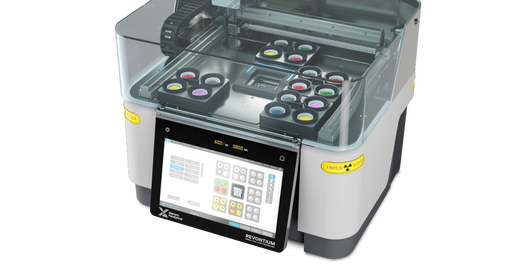
Die Elementaranalyse ist ein Eckpfeiler der pharmazeutischen Entwicklung und Herstellung, der die Qualität, Sicherheit und Wirksamkeit von Arzneimitteln und Produkten sicherstellt.
Mit der Elementaranalyse werden Verunreinigungen erkannt und die Reinheit geprüft. Dadurch trägt sie zur Einhaltung gesetzlicher Vorschriften und zum Schutz Gesundheit der Bevölkerung bei.
Elementaranalyse von pharmazeutischen Proben mit RFA
Die RFA bietet Geschwindigkeit, Genauigkeit und Effizienz zugleich und hilft so großen und kleinen Pharmaunternehmen, ihre Prozesse zu verbessern, Arbeitsabläufe zu optimieren, ihre Nachhaltigkeitsziele zu erreichen und ihre Produkte schneller auf den Markt zu bringen.
Entdecken Sie unser Sortiment an Röntgenfluoreszenz-Spektrometern
Die Herausforderungen von ICP für die Elementaranalyse
Derzeit sind ICP-OES und ICP-MS die Standardlösungen für die Elementaranalyse in der Pharmabranche. ICP bringt jedoch viele Herausforderungen mit sich:
- Vom Beginn der Probenvorbereitung bis zum Ergebnis können Tage oder sogar Wochen vergehen.
- Die Probenvorbereitung ist zeitaufwändig und dauert in einigen Fällen bis zu 48 Stunden.
- Pulverproben müssen zu Flüssigkeiten zersetzt werden, wofür starke Säuren und Mikrowellen erforderlich sein können, durch die Gesundheits- und Umweltrisiken entstehen.
- Sie ist arbeitsintensiv und erfordert tägliche Neukalibrierungen für die untersuchten Elemente sowie hochspezialisiertes Personal, das Methoden entwickelt und das Gerät betreibt.
- Eine spezielle Infrastruktur ist erforderlich. Dazu gehören Abzugshauben und Absauganlagen.
Röntgenfluoreszenzanalyse (RFA): Eine Alternative zu ICP
Energiedispersive Röntgenfluoreszenzanalyse (EDRFA)
Indem Sie energiedispersive Röntgenfluoreszenz (ED-RFA) in Ihren Arbeitsablauf aufnehmen, können Sie Ihren Arzneimittelentwicklungsprozess beschleunigen und die Markteinführungszeit deutlich verkürzen.
Sie ist schnell und zerstörungsfrei und somit eine robuste Screening-Lösung für die elementare Reinheit von Wirkstoffsubstanzen und pharmazeutischen Zwischen- und Endprodukten.
Durch Vielseitigkeit und Anwenderfreundlichkeit von ED-RFA ist sie für eine Vielzahl von Anwendungen in der Arzneimittelentwicklung und -herstellung geeignet.
Was ist Röntgenfluoreszenz?
Die RFA ist eine Atom-Emissionsmethode, die in dieser Hinsicht der optischen Emissionsspektroskopie (OES), der Massenspektrometrie mit induktiv gekoppeltem Plasma (ICP) und der Neutronenaktivierungsanalyse (Gamma-Spektroskopie) ähnelt.
Bei diesen Methoden werden die Wellenlänge und die Intensität von „Licht“ (in diesem Fall Röntgenstrahlen) gemessen, das von energetisierten Atomen in der Probe emittiert wird.
Bei der RFA verursacht die Strahlung eines primären Röntgenstrahls aus einer Röntgenröhre die Emission von fluoreszierenden Röntgenstrahlen mit diskreten Energiemerkmalen der in der Probe vorhandenen Elemente.
Hauptvorteile der RFA
- Geschwindigkeit und Effizienz
- Zerstörungsfrei: Analysiert Proben, ohne sie zu verändern oder zu zerstören, sodass Sie dieselbe Probe mehrmals und bei Bedarf mit verschiedenen Verfahren umfassend testen können. Dadurch sparen Sie sowohl Zeit als auch Ressourcen.
- Schnelle Ergebnisse: RFA liefert schnell genaue Ergebnisse. Dadurch wird die Entwicklung beschleunigt und die Kosten reduziert. Die Proben können in nur 2 Minuten vorbereitet werden, wonach hochwertige Daten in weniger als 30 Minuten vorliegen.
- Genauigkeit und Empfindlichkeit
- Hohe Präzision: Erkennt mit hoher Genauigkeit Elemente in Spurenmengen. RFA erreicht sehr niedrige Quantifizierungsgrenzen unterhalb der in der ICH Q3D festgelegten Grenzen.
- Breites Elementarspektrum: Kann eine Vielzahl von Elementen von Natrium bis Uran analysieren.
- Anwenderfreundlichkeit
- Minimale Probenvorbereitung: Die Probenvorbereitung für RFA ist schnell und einfach, was Zeit spart, das Risiko für Bedienerfehler reduziert und die Analyseprozesse vereinfacht.
- Anwenderfreundlich: Mit benutzerfreundlicher Software ist RFA sowohl erfahrene Anwender als auch für Nicht-Fachleute zugänglich.
Überblick über das RFA-Gerät
Malvern Panalytical bietet eine Reihe von Röntgenfluoreszenztechnologien an, die alle auf spezifische analytische Anforderungen zugeschnitten sind. Welches RFA-Spektrometer für Ihre Anwendung das Richtige ist, hängt von Faktoren wie Probentyp, erforderlicher Empfindlichkeit und Präzision ab.
| Epsilon 1 | Epsilon 4 | Revontium | |
|---|---|---|---|
| Übersicht | Erste Schritte | Automatisierung für höheren Durchsatz | Machen Sie Ihre Methoden durch Automatisierung für die Qualitätskontrolle und Einhaltung aller gesetzlichen Vorschriften bereit |
| Messempfindlichkeit | ✔ | ✔✔ | ✔✔✔ |
| Messzeit pro Probe | 10 Minuten für die Analyse von 5 Elementen | 45 Minuten für die Analyse von 20 Elementen gemäß ICH-Q3D | 30 Minuten für die Analyse von 20 Elementen gemäß ICH-Q3D |
| Probendurchsatz (Automatisierung) | 1 | 10 | 32 |
| Katalysatorrückstand gemäß der Richtlinie ICH Q3D* | ✔ | ✔ | ✔ |
| Nachweis toxischer Elemente gemäß der Richtlinie ICH Q3D* | -- | ✔
Tägliche Dosis 1 g* | ✔✔
Tägliche Dosis 10 g |
| Erkennung von Verschleißelementen (Cr, Mn, V, Ni, Cu) | ✔ | ✔ | ✔ |
| Erfahren Sie mehr | Entdecken Sie Epsilon 1 | Entdecken Sie Epsilon 4 | Entdecken Sie Revontium |
| *z. B. Die „großen Vier“: Cd, Pb, As, Hg [große Vier oder toxische Sieben] gemäß ICH Q3D-Richtlinie | |||
Unser Fachwissen
Mit jahrzehntelanger Erfahrung in der Pharmazie hat sich Malvern Panalytical einen exzellenten Ruf aufgebaut. Unser umfangreiches Portfolio an innovativen Geräten und Technologien ist darauf ausgelegt, die komplexen Anforderungen der pharmazeutischen Forschung, Entwicklung und Fertigung zu erfüllen.
Wir setzen uns für kontinuierliche Innovation und die Einhaltung höchster Qualitätsstandards ein. Malvern Panalytical investiert in Forschung und Entwicklung und bringt so immer wieder modernste Lösungen für die zunehmenden Herausforderungen in der Pharmazie, einschließlich der Auflösungsprüfung, auf den Markt.
Erfahren Sie mehr darüber, wie die RFA-Spektrometer Revontium- und Epsilon Ihren Workflow bei der Arzneimittelentwicklung verbessern können. Um mehr über die Anwendungsfälle von ED-RFA zu erfahren, kontaktieren Sie uns noch heute. Unsere Experten stehen Ihnen gerne mit detaillierten Informationen, Demonstrationen und maßgeschneiderten Lösungen zur Seite.



